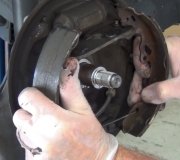Sounds like some common do-it-yourselfer mistakes were made. There are three things that can cause the red "brake" warning light to turn on. The most common is low fluid level in the master cylinder's reservoir. We never top those off during other routine services such as oil changes. If the fluid level is low, since the front pads are fairly new, it is okay to fill the reservoir almost to the "max" level. Be sure that fluid is clean, and you get absolutely no hint of petroleum product in there, like engine oil, transmission fluid, or power steering fluid.
Next time the warning light turns on, pull up lightly on the parking brake pedal. Applying the parking brake also turns on the red light. If pulling up on the pedal makes the light go off, the main cable has stretched and must be adjusted, or more commonly, a rear cable has rusted in the partially-applied position.
The brake hydraulic system is split into two parts. When you push the brake pedal, fluid pressure should build up equally in both parts. When one half does not build pressure, the red light turns on. The most common cause of that is failure of one half of the master cylinder caused by pushing the brake pedal all the way to the floor. Do-it-yourselfers and inexperienced mechanics often do that to run the pistons back out of the calipers right after installing new pads. People also do that when bleeding the brake hydraulic system improperly. This problem usually causes the red light to turn on only when pressing the brake pedal, but the valve that runs the switch, while spring-loaded, can stick at times. The clue is the light may turn off when the pedal is pushed another time. If the master cylinder was damaged, you should notice the brake pedal can be pushed further to the floor than normal, and/or the pedal will sink slowly to the floor when you hold steady pressure on it.
Thursday, November 16th, 2017 AT 5:53 PM


